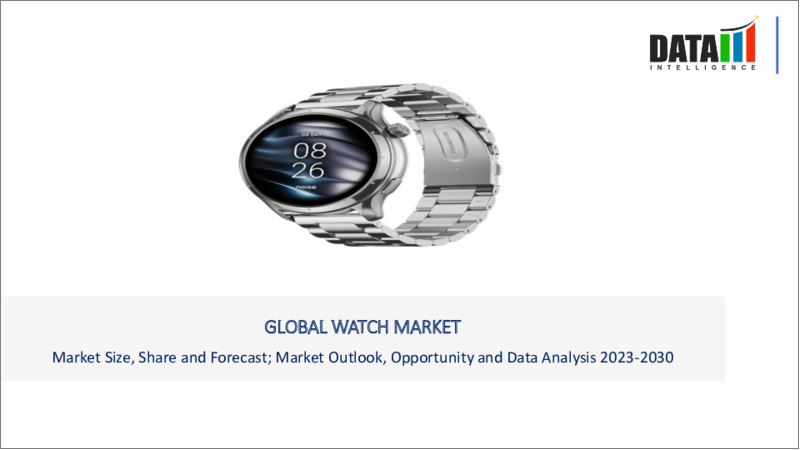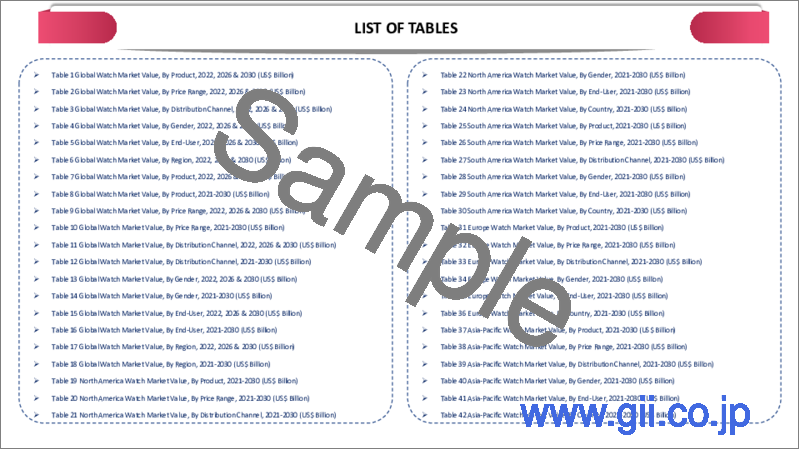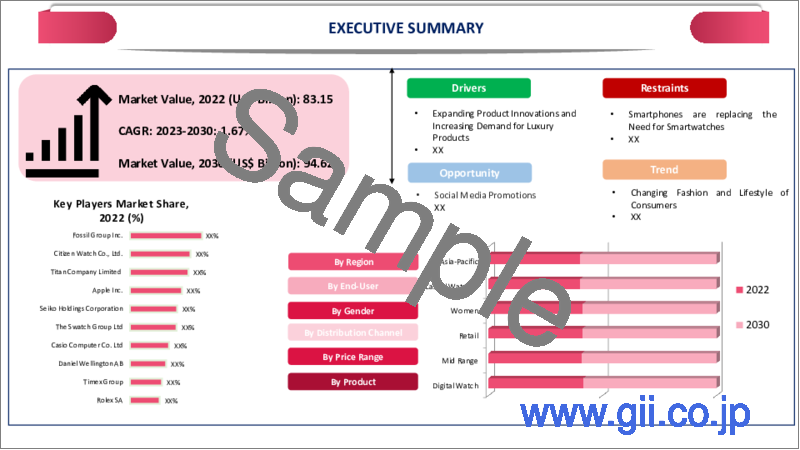|
|
市場調査レポート
商品コード
1336684
腕時計の世界市場-2023年~2030年Global Watch Market - 2023-2030 |
||||||
カスタマイズ可能
適宜更新あり
|
|||||||
| 腕時計の世界市場-2023年~2030年 |
|
出版日: 2023年08月22日
発行: DataM Intelligence
ページ情報: 英文 203 Pages
納期: 即日から翌営業日
|
- 全表示
- 概要
- 目次
市場概要
世界の腕時計市場は、2022年に716億米ドルに達し、2023-2030年の予測期間中にCAGR 4.9%で成長し、2030年には991億米ドルに達すると予測されています。ブランド認知とステータスシンボルへの注目の高まりが市場成長を後押しすると予想されます。高級腕時計は通常、ステータスシンボルや個人的な達成のシグナルとして見られます。ブランド識別の必要性と高級腕時計を持つことの威信が市場を牽引しています。
長い歴史と高い評判を持つ有名な高級腕時計ブランドは、消費者の需要を獲得する上で競争上の優位性を持っています。2022年、アジア太平洋の腕時計市場は世界市場の1/3以上を占める。特に中国、インド、日本などの主要国における消費者行動の変化と可処分所得の増加が、アジア太平洋市場の成長を牽引しています。
市場力学
高まる製品イノベーション
環境の持続可能性に対する消費者の意識が高まるにつれ、リサイクル素材や、竹、木材、再生プラスチックなどの持続可能な代替素材から製造された腕時計が開発されています。素材科学の進歩により、チタン、セラミック、カーボンファイバーなど軽量で耐久性のある素材が使われるようになり、腕時計の実用性と美しさが向上しています。
セイコー・ウオッチ・オブ・アメリカは、時代遅れの「青海波」デザインに敬意を表し、2つの特別な米国エクセプショナル・エディションを2021年8月に発売すると発表しました。米国市場でのみ発売されるこの腕時計は、最高の腕時計技術革新と数百年にわたるカスタムメイドとその作品を融合させたものです。
高級品への需要の高まり
消費者のニーズに応えるため、高級腕時計分野のメーカーは絶えず新しい商品を開発し、発表しています。それは、顧客が期待する耐久性と快適性を維持しながら、腕時計の品質と性能を向上させるために新しい技術や素材を使用することです。高級腕時計の消費者は、腕時計が精密にデザインされ、最高級の素材で作られていることを望んでいます。
購入者は高級腕時計ブランドをプレステージやステータスと認識することが多いため、ブランド力も販売に大きな影響を与えます。その結果、メーカー各社は消費者の需要に応えるため、新製品の投入に力を注いできました。例えば、ルイ・ヴィトンは2022年1月に「タンブールホライゾンライトアップ」シリーズを発表し、スマートウォッチコレクションを拡充しました。この製品には、カスタム設計のOS、LED通知ライト、専用の心拍数モニターが搭載されています。
偽造・模造腕時計
偽造・模倣腕時計は国際的な問題であり、その生産拠点は知的財産権保護が不十分な国に集中しています。偽造者は、匿名で活動でき、世界中のバイヤーに容易にアクセスできるオンラインマーケットを利用しています。低価格の模倣品やレプリカ腕時計が市場に出回ることで、本物の腕時計ブランドは値下げを迫られ、利益率を下げることになります。
インターネットが提供する匿名性とアクセスの容易さにより、偽造者は製品を販売することができ、当局がこれらの違法なビジネスを効率的に監視し、閉鎖することを困難にしています。模倣品やレプリカ腕時計は、正規の腕時計ブランドから売上を逸らし、その結果、正規のメーカーに直接的な収入と利益の損失をもたらします。
COVID-19影響分析
パンデミックの間、経済不安と大幅な雇用喪失は高級腕時計のような自由裁量商品への消費者の支出に影響を与えました。不要不急の買い物は多くの顧客によって延期され、腕時計全体の売上に影響を与えました。流行期間中は社交や旅行の機会が減少したため、消費者の嗜好はドレッシーな腕時計や高級腕時計よりも、よりカジュアルな機能的腕時計へと変化しました。
COVID-19の大流行に対処するため、腕時計メーカーはCOVID-19の初期徴候を検出する製品を改良し、発売しました。例えば、Apple Inc.は2021年9月にApple Watch Series 7を発表したが、これにはインフルエンザやCOVID-19などの呼吸器疾患の早期指標を検出する心拍センサーと血中酸素センサーが搭載されています。腕時計の製造に使用されるチップセットの価格が上昇しているため、スマートウェアラブルやスマートウォッチは2020年と比較して高価になっています。
ロシア・ウクライナ戦争の影響
一部の腕時計ブランドは、影響を受けた地域に製造工場やサプライヤーを有しています。政治的緊張やサプライチェーンの混乱は、彼らのオペレーションや製造能力に影響を与える可能性があります。腕時計市場には様々な素材が使用されており、その一部はロシア、ウクライナ、またはその近隣諸国からもたらされています。特定の素材における供給の混乱は、生産量や価格設定に影響を及ぼす可能性があります。
例えば、パテック・フィリップ、ロレックス、ウブロ、その他の高級ブランドの販売代理店であるマーキュリーは、短期的に店頭が空っぽになるのを防ぐため、入手可能なモデルの価格を3倍以上に引き上げました。二次流通業者や質屋も盛んになりましたが、高級腕時計の合法的で体系的な市場はもはや存在しません。
目次
第1章 調査手法と調査範囲
第2章 定義と概要
第3章 エグゼクティブサマリー
第4章 市場力学
- 影響要因
- 促進要因
- 製品イノベーションの高まり
- 高級品への需要の高まり
- 抑制要因
- 偽造品とレプリカ腕時計
- 機会
- 影響分析
- 促進要因
第5章 産業分析
- ポーターのファイブフォース分析
- サプライチェーン分析
- 価格分析
- 規制分析
第6章 COVID-19分析
第7章 製品別
- クオーツ腕時計
- デジタル
- スマート
- その他
第8章 価格帯別
- ローレンジ
- ミッドレンジ
- ラグジュアリー
- アルミニウム
- その他
第9章 流通チャネル別
- オンライン
- オフライン
第10章 エンドユーザー別
- 男性
- 女性
- ユニセックス
第11章 地域別
- 北米
- 米国
- カナダ
- メキシコ
- 欧州
- ドイツ
- 英国
- フランス
- イタリア
- ロシア
- その他欧州
- 南米
- ブラジル
- アルゼンチン
- その他南米
- アジア太平洋
- 中国
- インド
- 日本
- オーストラリア
- その他アジア太平洋
- 中東・アフリカ
第12章 競合情勢
- 競合シナリオ
- 市況/シェア分析
- M&A分析
第13章 企業プロファイル
- Fossil Group Inc.
- 会社概要
- 製品ポートフォリオと説明
- 財務概要
- 最近の動向
- Citizen Watch Co. Ltd
- Titan Company Limited
- Apple Inc.
- Seiko Holdings Corporation
- The Swatch Group Ltd
- Casio Computer Co. Ltd
- Daniel Wellington AB
- Timex Group
- Rolex SA
第14章 付録
Market Overview
Global Watch Market reached US$ 71.6 billion in 2022 and is expected to reach US$ 99.1 billion by 2030, growing with a CAGR of 4.9% during the forecast period 2023-2030. The growing focus on brand awareness and status symbols is expected to boost market growth. Luxury watches are usually seen as status symbols and personal accomplishment signals. The need for brand identification and the prestige of having luxury watches drives the market.
Renowned luxury watch brands with a long history and a good reputation have a competitive advantage when it comes to capturing consumer demand. In 2022, Asia-Pacific watch market will account for more than 1/3rd of the global market. Changing consumer behavior and rising disposable income, particularly in major nations such as China, India and Japan, are driving Asia-Pacific market growth.
Market Dynamics
The Rising Product Innovations
As consumer awareness of environmental sustainability grows, watches manufactured from recycled materials or sustainable alternatives such as bamboo, wood or recycled plastics are being developed. Materials science advancements have resulted in the usage of lightweight and durable materials such as titanium, ceramic and carbon fiber, increasing the utility and aesthetics of watches.
Seiko Watch of America has announced the release of two extraordinary U.S. Exceptional Editions honoring the outdated "Seigaiha" or "blue sea waves" design in August 2021. The watches, which are only available in U.S. market, combine the greatest watch innovation with hundreds of years of custom and their work.
The Growing Demand for Luxury Goods
To meet consumer needs, manufacturers in the luxury watch sector are continually developing and introducing new goods. It involves using new technologies and materials to improve watch quality and performance while keeping the durability and comfort that customers expect. Luxury watch consumers want watches to be precisely designed and made from the finest materials.
Branding also has a big impact on sales since buyers frequently identify luxury watch brands with prestige and status. As a consequence, manufacturers have focused on introducing new products to meet consumer demand. For example, Louis Vuitton increased their smartwatch collection in January 2022 with the introduction of the Tambour Horizon Light Up series. The product includes a custom-designed operating system, an LED notification light and a specialized heart-rate monitor.
Counterfeiting and Replica Watches
Counterfeit and imitation watches are a worldwide problem, with production hubs mostly concentrated in nations with inadequate intellectual property protection. Counterfeiters make use of the online marketplace, where they can operate anonymously and easily reach buyers all over the world. The availability of low-cost counterfeit and replica watches on the market can put pressure on real watch brands to cut their pricing, reducing profit margins.
With the anonymity and ease of access provided by the Internet, counterfeiters may market and sell their products, making it difficult for authorities to efficiently monitor and shut down these unlawful businesses. Counterfeit and replica watches divert sales away from authentic watch brands, resulting in direct revenue and profit losses for genuine manufacturers.
COVID-19 Impact Analysis
During the pandemic, economic uncertainty and significant job losses affected consumer expenditure on discretionary products such as luxury watches. Non-essential purchases were postponed by many customers, affecting overall watch sales. As there were less opportunities for socializing and travel during the epidemic, consumer preferences switched toward more casual functional watches rather than dressier or luxury watches.
To deal with the COVID-19 pandemic, wristwatch manufacturers have improved and introduced products that detect COVID-19 early signs in individuals. For example, Apple Inc. released the Apple Watch Series 7 in September 2021, which includes heart rate and blood oxygen sensors to detect early indicators of respiratory illnesses such as influenza and COVID-19. Owing to the growing pricing of chipsets used to produce watches, smart wearables and smartwatches have grown more expensive in comparison to 2020.
Russia- Ukraine War Impact
Some watch brands have manufacturing plants or suppliers in the affected areas. Political tensions and supply chain disruptions could have an influence on their operations and manufacturing capacity. The watch market uses a wide range of materials, some of which come from Russia, Ukraine or close nations. Supply disruptions in certain materials could have an impact on output and pricing.
Mercury, for example, the distributor of Patek Philippe, Rolex, Hublot and other premium brands, has increased or tripled the cost of available models in order to prevent having empty shop windows in the short term. Secondary-market players and pawn shops have also flourished, but there is no longer a legitimate, structured market for luxury watches.
Segment Analysis
The global watch market is segmented based on product, price range, distribution channel, end-user and region.
The Favorable Valued-Added Services in the Online Distribution Channel
Online distribution channel is expected to grow at a significant rate and hold about 30.2% of the global watch market during the forecast period 2023-2030. Consumers prefer to buy luxury products through online channels because of useful value-added services such as cash-on-delivery, rapid return options, secure transactions and integrated and centralized customer support.
To reduce operational expenses and improve earnings, key firms are setting up online retail systems. Companies like Rolex Inc., Fossil Group and Ralph Lauren have a strong web presence and sell their items online to expand their market reach. The distribution channel also allows producers to offer their items on a global scale.
Geographical Analysis
The Strong Demand for Smartwatch in North America
North America is anticipated to have a significant growth holding around 1/4th of the global watch market during the forecast period 2023-2030. Several manufacturers in the region are incorporating this 'healthcare factor' to distinguish smartwatches from smartphones in terms of operation and to overcome the 'product objective challenge,' because consumers need a reason to purchase a wrist gadget that provides everything smartphones already do.
The recent version of Apple Watch offers to take electrocardiograms or ECGs, a capability approved by U.S. Food and Drug Administration (FDA). Features like this, that offer access to real-time data on this scale, have the potential to change healthcare operations, driving the region's watch industry. It was also endorsed by Ivor Benjamin, a cardiologist and the president of the American Heart Association.
Competitive Landscape
The major global players include: Fossil Group Inc., Citizen Watch Co. Ltd, Titan Company Limited, Apple Inc., Seiko Holdings Corporation, The Swatch Group Ltd, Casio Computer Co. Ltd, Daniel Wellington AB, Timex Group and Rolex SA.
Why Purchase the Report?
- To visualize the global watch market segmentation based on product, price range, distribution channel, end-user and region, as well as understand key commercial assets and players.
- Identify commercial opportunities by analyzing trends and co-development.
- Excel data sheet with numerous data points of watch market-level with all segments.
- PDF report consists of a comprehensive analysis after exhaustive qualitative interviews and an in-depth study.
- Product mapping available as Excel consisting of key products of all the major players.
The global watch market report would provide approximately 69 tables, 65 figures and 203 Pages.
Target Audience 2023
- Manufacturers/ Buyers
- Industry Investors/Investment Bankers
- Research Professionals
- Emerging Companies
Table of Contents
1. Methodology and Scope
- 1.1. Research Methodology
- 1.2. Research Objective and Scope of the Report
2. Definition and Overview
3. Executive Summary
- 3.1. Snippet by Product
- 3.2. Snippet by Price Range
- 3.3. Snippet by Distribution Channel
- 3.4. Snippet by End-User
- 3.5. Snippet by Region
4. Dynamics
- 4.1. Impacting Factors
- 4.1.1. Drivers
- 4.1.1.1. The Rising Product Innovations
- 4.1.1.2. The Growing Demand for Luxury Goods
- 4.1.2. Restraints
- 4.1.2.1. Counterfeiting and Replica Watches
- 4.1.3. Opportunity
- 4.1.4. Impact Analysis
- 4.1.1. Drivers
5. Industry Analysis
- 5.1. Porter's Five Force Analysis
- 5.2. Supply Chain Analysis
- 5.3. Pricing Analysis
- 5.4. Regulatory Analysis
6. COVID-19 Analysis
- 6.1. Analysis of COVID-19
- 6.1.1. Scenario Before COVID
- 6.1.2. Scenario During COVID
- 6.1.3. Scenario Post COVID
- 6.2. Pricing Dynamics Amid COVID-19
- 6.3. Demand-Supply Spectrum
- 6.4. Government Initiatives Related to the Market During Pandemic
- 6.5. Manufacturers Strategic Initiatives
- 6.6. Conclusion
7. By Product
- 7.1. Introduction
- 7.1.1. Market Size Analysis and Y-o-Y Growth Analysis (%), By Product
- 7.1.2. Market Attractiveness Index, By Product
- 7.2. Quartz Watch*
- 7.2.1. Introduction
- 7.2.2. Market Size Analysis and Y-o-Y Growth Analysis (%)
- 7.3. Digital
- 7.3.1. Smart
- 7.3.2. Others
8. By Price Range
- 8.1. Introduction
- 8.1.1. Market Size Analysis and Y-o-Y Growth Analysis (%), By Price Range
- 8.1.2. Market Attractiveness Index, By Price Range
- 8.2. Low Range*
- 8.2.1. Introduction
- 8.2.2. Market Size Analysis and Y-o-Y Growth Analysis (%)
- 8.3. Mid Range
- 8.4. Luxury
- 8.5. Aluminum
- 8.6. Others
9. By Distribution Channel
- 9.1. Introduction
- 9.1.1. Market Size Analysis and Y-o-Y Growth Analysis (%), By Distribution Channel
- 9.1.2. Market Attractiveness Index, By Distribution Channel
- 9.2. Online*
- 9.2.1. Introduction
- 9.2.2. Market Size Analysis and Y-o-Y Growth Analysis (%)
- 9.3. Offline
10. By End-User
- 10.1. Introduction
- 10.1.1. Market Size Analysis and Y-o-Y Growth Analysis (%), By End-User
- 10.1.2. Market Attractiveness Index, By End-User
- 10.2. Men*
- 10.2.1. Introduction
- 10.2.2. Market Size Analysis and Y-o-Y Growth Analysis (%)
- 10.3. Women
- 10.4. Unisex
11. By Region
- 11.1. Introduction
- 11.1.1. Market Size Analysis and Y-o-Y Growth Analysis (%), By Region
- 11.1.2. Market Attractiveness Index, By Region
- 11.2. North America
- 11.2.1. Introduction
- 11.2.2. Key Region-Specific Dynamics
- 11.2.3. Market Size Analysis and Y-o-Y Growth Analysis (%), By Product
- 11.2.4. Market Size Analysis and Y-o-Y Growth Analysis (%), By Price Range
- 11.2.5. Market Size Analysis and Y-o-Y Growth Analysis (%), By Distribution Channel
- 11.2.6. Market Size Analysis and Y-o-Y Growth Analysis (%), By End-User
- 11.2.7. Market Size Analysis and Y-o-Y Growth Analysis (%), By Country
- 11.2.7.1. U.S.
- 11.2.7.2. Canada
- 11.2.7.3. Mexico
- 11.3. Europe
- 11.3.1. Introduction
- 11.3.2. Key Region-Specific Dynamics
- 11.3.3. Market Size Analysis and Y-o-Y Growth Analysis (%), By Product
- 11.3.4. Market Size Analysis and Y-o-Y Growth Analysis (%), By Price Range
- 11.3.5. Market Size Analysis and Y-o-Y Growth Analysis (%), By Distribution Channel
- 11.3.6. Market Size Analysis and Y-o-Y Growth Analysis (%), By End-User
- 11.3.7. Market Size Analysis and Y-o-Y Growth Analysis (%), By Country
- 11.3.7.1. Germany
- 11.3.7.2. UK
- 11.3.7.3. France
- 11.3.7.4. Italy
- 11.3.7.5. Russia
- 11.3.7.6. Rest of Europe
- 11.4. South America
- 11.4.1. Introduction
- 11.4.2. Key Region-Specific Dynamics
- 11.4.3. Market Size Analysis and Y-o-Y Growth Analysis (%), By Product
- 11.4.4. Market Size Analysis and Y-o-Y Growth Analysis (%), By Price Range
- 11.4.5. Market Size Analysis and Y-o-Y Growth Analysis (%), By Distribution Channel
- 11.4.6. Market Size Analysis and Y-o-Y Growth Analysis (%), By End-User
- 11.4.7. Market Size Analysis and Y-o-Y Growth Analysis (%), By Country
- 11.4.7.1. Brazil
- 11.4.7.2. Argentina
- 11.4.7.3. Rest of South America
- 11.5. Asia-Pacific
- 11.5.1. Introduction
- 11.5.2. Key Region-Specific Dynamics
- 11.5.3. Market Size Analysis and Y-o-Y Growth Analysis (%), By Product
- 11.5.4. Market Size Analysis and Y-o-Y Growth Analysis (%), By Price Range
- 11.5.5. Market Size Analysis and Y-o-Y Growth Analysis (%), By Distribution Channel
- 11.5.6. Market Size Analysis and Y-o-Y Growth Analysis (%), By End-User
- 11.5.7. Market Size Analysis and Y-o-Y Growth Analysis (%), By Country
- 11.5.7.1. China
- 11.5.7.2. India
- 11.5.7.3. Japan
- 11.5.7.4. Australia
- 11.5.7.5. Rest of Asia-Pacific
- 11.6. Middle East and Africa
- 11.6.1. Introduction
- 11.6.2. Key Region-Specific Dynamics
- 11.6.3. Market Size Analysis and Y-o-Y Growth Analysis (%), By Product
- 11.6.4. Market Size Analysis and Y-o-Y Growth Analysis (%), By Price Range
- 11.6.5. Market Size Analysis and Y-o-Y Growth Analysis (%), By Distribution Channel
- 11.6.6. Market Size Analysis and Y-o-Y Growth Analysis (%), By End-User
12. Competitive Landscape
- 12.1. Competitive Scenario
- 12.2. Market Positioning/Share Analysis
- 12.3. Mergers and Acquisitions Analysis
13. Company Profiles
- 13.1. Fossil Group Inc.*
- 13.1.1. Company Overview
- 13.1.2. Product Portfolio and Description
- 13.1.3. Financial Overview
- 13.1.4. Recent Developments
- 13.2. Citizen Watch Co. Ltd
- 13.3. Titan Company Limited
- 13.4. Apple Inc.
- 13.5. Seiko Holdings Corporation
- 13.6. The Swatch Group Ltd
- 13.7. Casio Computer Co. Ltd
- 13.8. Daniel Wellington AB
- 13.9. Timex Group
- 13.10. Rolex SA
LIST NOT EXHAUSTIVE
14. Appendix
- 14.1. About Us and Services
- 14.2. Contact Us





